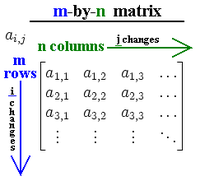Famous Theorems of Mathematics/Algebra/Matrix Theory

An m×n matrix M is a function where A = {1,2...m} × {1,2...n} and F is the field under consideration.
An m×n matrix (read as m by n matrix), is usually written as:
For other related definitions please see this link.
Basic Proofs
1. The set of all m×n matrices forms an abelian group under matrix addition.
- Proof: Clearly the sum of two m×n matrices is another m×n matrix. If A and B are two matrices of equal order then working with their (i,j)th entries we have which proves A+B = B+A i.e. commutativity. For associativity we proceed similarly so that A + (B + C) = (A + B) + C. Also the m×n matrix with all entries zero is the additive identity. For every matrix A, the matrix -A whose (i,j)th entry is is the inverse. So matrices of same order form an abelian group under addition.
2. Scalar Multiplication has the following properties:
- 1. Left distributivity: (α+β)A = αA+βA.
- 2. Right distributivity: α(A+B) = αA+αB.
- 3. Associativity: (αβ)A=α(βA)).
- 4. 1A = A.
- 5. 0A= 0.
- 6. (-1)A = -A.
- (0,1,-1,α & β are scalars; A & B are matrices of equal order, 0 is the zero matrix.)
- Proof: Start with the left hand side of (1). We will work with the (i,j)th entries. Clearly and so (1) is proved. Similarly (2) can be proved. Associativity follows as . (4), (5) and (6) follow directly from the definition.
3. Matrix multiplication has the following properties:
- 1. Associativity: A(BC) = (AB)C.
- 2. Left distributivity: A(B+C) = AB+AC.
- 3. Right distributivity: (A+B)C = AC+BC.
- 4. IA = A = AI.
- 5. α(BC) = (αB)C = B(αC).
- (α is a scalar; A, B & C are matrices, I is the identity matrix. A,B,C & I are of orders m×n, n×p, p×r & m×m respectively.)
- Proof: We work with the (i,j)th entries and prove (1) only. The proofs for the rest are similar. Now and also so that (i,j)th entries on the two sides are equal.
4. Let A and B be m×n matrices. Then:
- (i) =
- (ii)
- (iii)
- Sketch of Proof: Work with the (i,j) entries as in the previous proofs.
5. Any system of linear equations has either no solution, exactly one solution or infinitely many solutions.
- Proof: Suppose a linear system Ax = b has two different solutions given by X and Y. Then let Z = X - Y. Clearly Z is non zero and A(X + kZ) = AX + kAZ = b + k(AX - AY) = b + k(b - b) = b so that X + kZ is a solution to the system for every possible value of k. Since k can assume infinitely many values so clearly we have an infinite number of solutions.
6. Any triangular matrix A satisfying is a diagonal matrix.
- Proof: Suppose A is lower triangular. Now the (i,i)th entry of is given by . Also the (i,i)th entry of is given by . Now as so and as can be subtracted from the two sides we are left with .
Now if i = 1 then we have which gives us . Similarly for i =2 we have so that . It is now clear that in this fashion all non diagonal entries of A can be shown to be zero. The proof for an upper triangular matrix is similar.